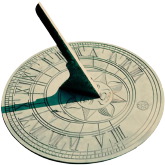Sundials, Ancient Clocks
 The earliest and simplest form of sundial is the shadow stick. The time of day is judged by the length and position of the stick's shadow. Some nomadic peoples still use this method for timekeeping. The technical name for a shadow stick is a gnomon. As the sun moves through the sky from sunrise to sunset, the shadow of the gnomon rotates 'clockwise.' The shadow is shortest when the sun is directly in the south, defining local noon.
The earliest and simplest form of sundial is the shadow stick. The time of day is judged by the length and position of the stick's shadow. Some nomadic peoples still use this method for timekeeping. The technical name for a shadow stick is a gnomon. As the sun moves through the sky from sunrise to sunset, the shadow of the gnomon rotates 'clockwise.' The shadow is shortest when the sun is directly in the south, defining local noon.
As early as 3500 B.C. the Egyptians began building slender, tapering, four-sided obelisks which served as timepieces. The moving shadow of the obelisk formed a type of sundial, and markers arranged about the base separated the day into divisions as well as indicating the longest and shortest days of the year. However, because of the earth's tilt, the sun's path through the sky changes slightly from day to day, so the shadow cast by the gnomon is not the same every day. Many sundials overcome this problem by angling the gnomon and aiming it north. This type of gnomon is called a style. Because its alignment compensates for the Earth's tilt, the hour marks remain the same all year round.
In the quest for accuracy, many types of sundials evolved, including some very complex portable sundials. In about 30 B.C. Marcus Vitruvius, a Roman architect, described 13 different sundial designs used in Greece, Asia Minor, and Itay. The invention of more accurate mechanical clocks and the standardization of time using time zones made sundials obsolete. Now sundials are used mostly for ornamental purposes.
About the Author
NASA Marshall Space Flight Center
 The George C. Marshall Space Flight Center, located in Huntsville, Alabama, is the U.S. government's civilian rocketry and spacecraft propulsion research center. As the largest NASA center, MSFC's first mission was developing the Saturn launch vehicles for the Apollo program.
The George C. Marshall Space Flight Center, located in Huntsville, Alabama, is the U.S. government's civilian rocketry and spacecraft propulsion research center. As the largest NASA center, MSFC's first mission was developing the Saturn launch vehicles for the Apollo program.


